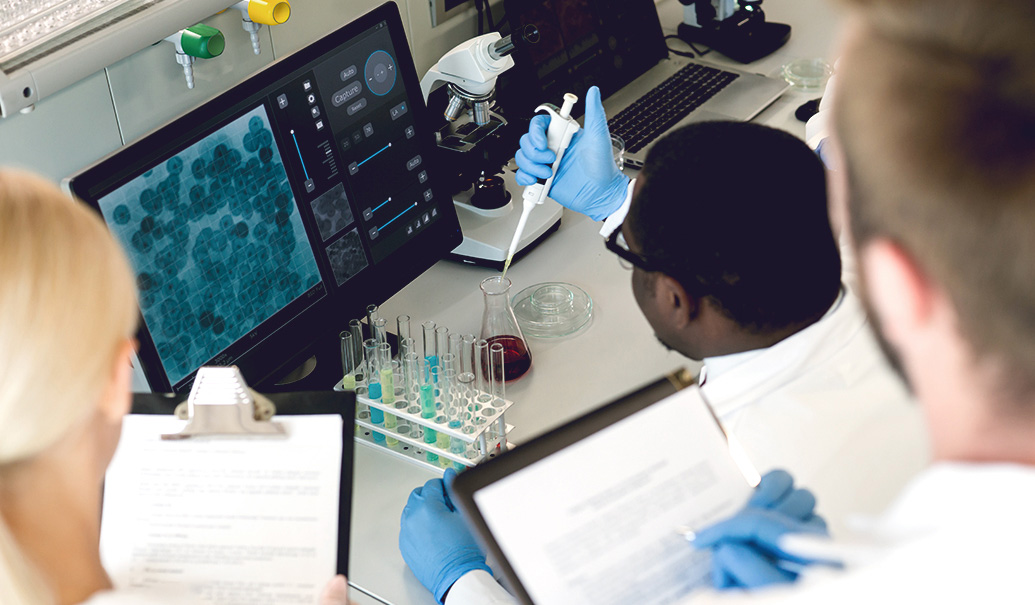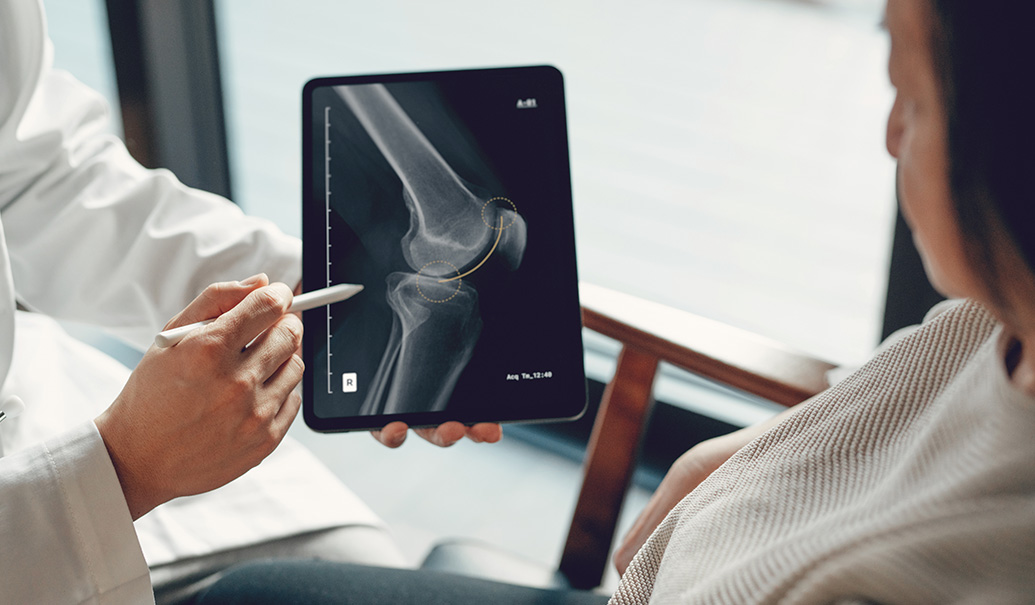Despite the continued rise in cancer rates around the world, medical science continues to make significant strides toward fighting the disease due to advances in data gathering and analysis, which have provided oncology-focused organizations with a new look at cancer’s underlying causes. By gaining greater insight into the innate complexities of the disease, researchers and manufacturers have opened doors to innovations that include genomic profiling and personalized medicine.
Foundation Medicine, Inc. (FMI) is a leader in tumor testing using sophisticated DNA sequencing techniques. ZS Principal Brian Chapman recently sat down with FMI’s CEO Cindy Perettie for an in-depth discussion on how evolving data methodology, as well as strategic partnerships, have helped them develop better cancer diagnostics to inform treatment decisions, leading to more encouraging patient outcomes.
Brian Chapman: How is genomic data already transforming oncology? How do you see [those transformations] proceeding in the future?
Cindy Perettie: For genomic data, being able to look at personalized mutations and understand the underlying driver of an individual’s cancer has been game-changing. You have a chance to have higher response rates and attack the cancer in a very personalized fashion. It’s made a difference in patient outcomes but also feeds back nicely into research and development. As we see more prevalence in certain drivers or mutations, what you see is that learning loop of biopharma companies then developing drugs to address those mutations. That loop is something that I feel Foundation Medicine has done well through our biopharma collaborations. We have about 60 collaborations at this point. We work closely with biopharma to develop companion diagnostics, as an example, but we also have the opportunity to better understand the underlying drivers of disease to support therapeutic development programs.
BC: You said there’s a substantial change in helping your partners target R&D. Are the insights you gain available equally to everybody across your collaborations, or are certain collaborations focused in certain areas? How do you demarcate the business relationships?
CP: What we share back with the physician and the patient from our reports are essentially the top drivers or mutations for their cancer. Parallel to that, we provide the approved drug and clinical trials that patients could match to, so if they don't match to a marketed therapy they could potentially go on a clinical trial. Today we have a genomic database that has about 400,000 patients in it, looking at a wide variety across over 20 cancer types today. We have an opportunity to look at that database in collaboration with pharma companies and ask, for example, how many patients show up with an ALK mutation or how many with a KIT mutation? I could use Piqray as an example, which is a recently approved therapy for breast cancer from Novartis. The driver of breast cancer is a PI3K mutation. A majority of those [with PI3K] are breast cancer patients, but looking at our data further, we also see that we have about 2,000 patients sitting outside of breast cancer. So we could partner with Novartis to identify those patients and think about what type of clinical trials or other diseases they would want to study [Piqray] in. The other way that we partner with biopharma companies is testing patients when we’re doing clinical trials so that they can enroll. I was on the other side of this when I was at Genentech and Roche, where we enrolled a large phase II trial for Ipatasertib, an AKT inhibitor. What we found in the trial is that the outcomes were not as robust as needed. When we went back and looked at the patients who were responders, FMI was able to identify a genomic signature of patients who had a much more robust response. They came back and said, “Of your responders, if you look across these sets of genes, you'll find that these patients respond exceptionally well.” So Genentech and Roche were able to take that gene signature into a phase III trial and look at only those patients. We take similar approaches to data-driven R&D across our biopharma collaborations.
BC: I’m interested in this idea of how to identify underserved patients: Maybe they don’t have a therapeutic option, or they may be in a country that isn’t providing therapeutic opportunities. To what degree will your partners seek to understand where these patients exist, and could they find their way to paying for a therapy or improving a therapy?
CP: Last year was a phenomenal year in that we had our first pan tumor approval with NTRK, which is a very rare mutation, [although] it occurs across 18 major tumor types. It’s less than 1% in a majority of those, so this is an underserved population in the sense that finding patients is tricky. There were two companies, Loxo and Ignyta, that were running clinical trials with an NTRK inhibitor. For both of them, we were able to identify the patients out of our database and tell them where they were, and they both enrolled their trials in less than a year. We’re excited because they both developed therapies towards those patients and it allowed for a great partnership. Then, as those therapies were approved, we were able to support them with additional safety data through a collaboration with Flatiron Health, where we have a comprehensive clinical and genomic database that shows outcomes data.
BC: How are these collaborations improving outcomes?
CP: The ability to do this quickly and get this information to patients was phenomenal. The partnership with the regulatory agencies, who could see the value, was phenomenal. So how do you help ensure that payers recognize the value of these therapies to underserved populations? This again is where our clinico-genomic database comes into play. Our collaboration with Flatiron Health includes a clinico-genomic database with over 55,000 patients and is growing on a monthly basis. We’re able to take the deep genomic data from our tests, coupled with clinical outcomes data from Flatiron Health, and provide those as real-world data to payers or to regulatory agencies. We’ve done this in several cases with biopharma companies to allow for submissions to both regulators and payers globally. One of the more prominent examples of this is with ALK. Crizotinib, Alecensa … there’s a number of ALK inhibitors now, but when ALK therapies were coming to market we used clinical genomic data to expand the database to give payers more comfort approving these types of therapies.
BC: How do you get access to the Flatiron database? What keeps us from tracking outcomes for all the patients on therapy and expanding this even further?
CP: Part of it is that we want to remain HIPAA compliant, so we have a third-party vendor that matches these patients. What it means with Flatiron in particular is that we would have to be enrolling or testing a patient at a site with a Flatiron EMR. We have about 55,000 patients that have been identified for that overlap. That’s growing every day because we’re often in very similar sites. The second component is third-party matching that then allows us to aggregate and clean the blinded data. That takes a bit of time, and every month we’re putting in more patients. It’s a timing issue. How we do that everywhere is something that we’re passionate about. Our ability to talk to other groups that have EMR is something that we’re focused on so that we have the opportunity to do this more broadly around the globe.
BC: How do geographic constraints, privacy and other such limitations shape those partnerships and outcomes?
CP: We see major differences around the globe in data, data rights and ability to test. In some countries, there are challenges with tissue or blood leaving the country. In China, for example, we’ve set up a collaboration with two companies, WuXi and DiAn, so that we can do the testing and capture the data in China and look at ways to leverage that down the road. The other testing facility we have is in Penzburg, outside of Munich, where we send most of our samples from Europe, the Middle East and Africa so that we can do testing within the European Union. We are testing Japanese patients in Cambridge [Massachusetts], working closely with Chugai in Japan. We have also done collaborations with major institutions where we can look at marrying the testing with clinical outcomes data. We have an ongoing collaboration with C-CAT, a cooperative group in Japan.
BC: The power of all of this data, especially when we’re talking about rare disease patients, comes when you can bring it up to an aggregate level. Are you able to do the testing in local places but then bring global insights, or do you have to only analyze, let’s say, Chinese data within China? How do you navigate that?
CP: With China in particular, the regulatory landscape is changing on a day-to-day basis, so we’re trying to stay in front of that. We work very closely with HGRAC. Having a strong relationship with Roche helps us because it gives us an opportunity to have discussions at the regulatory-body level in collaboration with local testing companies. We’ve been able to make good progress, but it requires a lot of discussion and alignment to get to that. The other piece that is important about how we do this everywhere is to remind ourselves that today 60% of people are not getting testing. A small fraction of everybody with metastatic disease, about 16 to 18%, get comprehensive genomic profiling. Up to 40% get single-marker testing. Then we see that 40% are not getting anything. Our goal is education and making sure providers, payers and patients understand the benefits of comprehensive genomic profiling, which allows you to select targeted therapies that allow your patient to have the best possible outcomes. From a payer perspective, having better outcomes and not having the person hospitalized off and on is better for the system. We have a ways to go to make sure that every patient can get comprehensive genomic profiling.
BC: There’s a fascinating world you can start to envision where we wouldn’t discuss second-line treatments. We would decide what first line treatment is based on perfectly understanding the patient's condition and the therapies available.
CP: One of the other things we’re excited about is that we signed a deal with Natera to do a collaboration around monitoring, which allows us to understand if the patient’s still responding to therapy. If the patient stops responding, you can make a decision to switch to second line versus saying, “I’ve signed up; the FDA approval is eight cycles.” If we see that patient responding for eight cycles, great. But if we see that patient stop responding at three cycles, they have an opportunity to stop and switch therapies and move into second line. This is exciting technology leveraged from the pregnancy detection industry—to pick up one circulating tumor DNA and understand if that patient’s progressing.
We’ve also just recently acquired a company called Lexent Bio, which will further support R&D in the monitoring space, ultimately allowing us to evaluate disease progression and inform treatment decisions at earlier stages of disease.
BC: It seems to me that the type of information you’re aggregating on the front end about selecting therapy, and on the back end around making the decisions to stop and start, would be valuable for many different players. Is there anything happening at the government level toward building a national registry?
CP: There have been a few efforts put forward at a national level. I’ll use the U.K. and Australia as examples because they’re making investments into genomics and genetics beyond just oncology. The U.K. is looking at whole exome sequencing for patients with oncology and other disorders, and they discovered that it’s quite costly. They were able to do 10,000 patients and that exhausted their NHS budget for the year. So the question is how would you scale that? Australia has just announced in the last eight months that they’re going to be investing similarly. So how do we do these local collaborations? [We’re leveraging] the partnership with Roche, which has operations in every country and is very well connected with the government. We have an ongoing pilot today with Flatiron in the U.K. at the Christie, which is one of the biggest oncology institutions in the U.K. We’ve embedded both the EMR from Flatiron as well as testing from Foundation and have the ability to capture the Christie data in that format. We’ll have an opportunity to share that at the government level. We’re also doing collaborations in the Czech Republic and collaborations in Singapore at the government level.
BC: When it comes to government collaborations, I look at who benefits and try to scale it out to say: “How would you build an initiative? Who would have the resources?” Are you able to potentially extract insights and apply them more broadly, or are Singapore’s systems only relevant to Singapore?
CP: I think every country is different. Japan operates similarly to the U.S. with their regulatory approvals and reimbursement processes. We have worked closely with Chugai to get regulatory approval of our tissue tests there with all of the CDxs that we offer. These pilots are different depending on the country, and I think having that flexibility is important. One thing to point out, though, is that volume makes a difference in testing. We have a small lab in Zurich that’s running our test. What we found out in partnership with the university there is that there is a threshold that allows you to break even. In many of these countries we’ll struggle to break even. We run probably anywhere from 100,000 to 160,000 tests. If you’re looking at a country like Switzerland, you may run 10,000 or 12,000 tests across the entire country. That would mean you would have to get every single one of those tests plus four other countries to be able to do this in a meaningful way to break even, but also to have meaningful data. For countries like China, it could make more sense if the government decided they wanted to reimburse for this and that they were going to do it broadly. For other countries, it’s a real challenge.
BC: There’s not a kit, and there’s not an obvious argument in the near term for a more distributed model, which might be common in other places.
CP: I think it all depends. One of the things we find is that having a full plate allows you to be most effective. We’re running probably about 500 to 700 assays a day here. We’re open seven days a week and we run three shifts. You have to think about that model. In some cases, it will work. In a major city like Seoul you can imagine Samsung Hospital doing this on their own. In other places it’s going to be challenging. Having centralized as well as distributed offerings as is going to be important to drive ubiquity for testing in the future.
BC: There’s also the return to scale from the data itself. How do you manage that if you have different collaborations in different locations? How do you eventually get to not just ubiquity in testing but ubiquity in the way in which you can analyze the results?
CP: One of the major investments that we’re making is having the cloud within each country, having the infrastructure set up so that it can serve either an individual country like China or 20 countries like Europe. Then, can you combine the data sets or do you need to use them locally? That’s the golden question we’re all trying to answer. The other thing to think about is that we see distinct differentiation between the Asian population and the European or U.S.-based populations. ALK-positive patients are somewhere around 7% in Asia and more around 5% in the U.S. If you look at every mutation, you see those types of differences. So maybe having localized data isn’t such a bad thing.
BC: It seems to me that the constituency that benefits greatly from the insights and vision that you have is biopharma. I would think that biopharma would also really want to drive penetration. Is there a way that biopharma might eventually pay for the test to drive ubiquity in testing?
CP: In our minds, getting decision insights to the point of care is most important to the physician and to the patients. So it’s bigger than biopharma, but let’s talk about that component. If you look at the collaborations and the number of CDxs that we currently have on any of our assays, you understand that the drivers are important. And every country operates differently. In Canada, you’re often asked to provide testing for free for the first three years if you have a companion diagnostic. That could be single-marker testing or comprehensive profiling. After the three years, it’s picked up by their national system, Health Canada. We look at the relationship with biopharma as a collaboration that goes hand-in-hand, each learning from each other. Testing would be available, but it wouldn’t be used unless there were therapies that would drive that use. Would biopharma ultimately pay for testing? I don’t know the answer to that. In some countries it’s required for a period of time, but in the United States that’s not the case.
BC: The traditional mechanism, especially for a rare disease with a limited population, is that biopharma companies may develop a single companion test to identify their patients, or a whole slew of companion tests to try to figure out the best thing to do for the patient. Do we need these single-marker companion diagnostics if we have comprehensive profiling?
CP: For some therapies, companion diagnostics can validate that a patient has a specific driver. We’re part of the clinical trial, and then we go through a parallel regulatory approval with the company as they go through their drug approval. So you can show that identifying that patient with our test leads to the outcomes with which they’re filing. I’m a firm believer that as we see more and more of these drivers comprehensive genomic profiling is going to make sense. We had a paper in JAMA last year showing the value of doing comprehensive genomic profiling versus a single-marker test. Lung cancer was the first area where you were able to validate that. Breast cancer, prostate cancer and ovarian cancer are hitting that inflection point. With some of the new therapies we’re seeing in colorectal, it’s also going to be hitting that inflection point. For NTRK, it’s a must to do comprehensive profiling or you won’t pick those patients up. One by one, as the diseases get more markers identified and more matched therapies, you’re going to see that it costs more to do single-marker testing than it is to do profiling.
BC: It seems very clear that real-world data is a key component for diagnostics and treatment decisions. How do you see it being used in terms of drug approvals and regulation? What role do you think it might play in future clinical trials?
CP: In the last two years we’ve seen much more openness from global regulators to using real-world data sets for approval. One example was with Ibrance, a drug for HER2-negative breast cancer. It's primarily used by women, but Pfizer was able to capture data for men and get an approval for men to use Ibrance off of real-world data sets. That’s an example of a more niche population; you don’t want those people to not have the same opportunities. Real-world data is going to play a critical role going forward. My dream would be that in every clinical trial, whether it’s a major or minor tumor type, the randomization of the control arm is four to one because I just hate the thought of a patient not getting a chance at active therapy. It would reflect what real-world data could mean to genomic alterations in cancer.
BC: We’ve seen that regulators can be much more pragmatic about approval due to the amount of noise in the data, which makes real-world data that much more important. It has implications for companies in how they seek reimbursement or approval. Are biopharma companies moving in a progressive way, or is it being driven more by regulatory agencies?
CP: I think it’s a mix. It’s nice to see the regulators embracing it and suggesting it to companies, but I think we see it on both sides. You hit the nail on the head when you said “noise in the data.” One of the things that the FDA has been hesitant on with pharma companies is about how good the data is. How clean is it? How validated? It’s an investment to make sure data sets are validated for regulatory and for payer purposes. We started putting the Flatiron and Foundation Clinico-Genomic Database data set together in 2014, and we spent a lot of time validating the data set to get to the point where it was accepted by EMA and FDA. We’re going to see it grow rapidly because we took the time to put the foundation together. I feel good about the data set we have; it’s going to give biopharma, regulators and payers confidence.
BC: It’s similar to having trust in a brand. It goes beyond having assembled the database for a single purpose and demonstrates the value of the partnerships you already trust.














